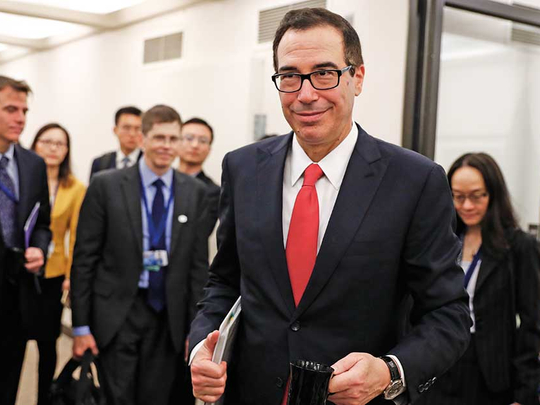
Washington
The tax code became too expensive and burdensome under former President Barack Obama’s administration, making a review of 2016 and 2017 tax rules necessary, Treasury Secretary Steven Mnuchin said.
And although President Donald Trump’s administration is already pushing for a comprehensive overhaul of the US tax code in legislation, it’s important to review Obama-era regulations as well, Mnuchin said on Friday at the White House, where he detailed the provisions in an executive order later signed by President Donald Trump.
“This has to do with the complexity of tax regulations — some of those issues may be addressed in tax reform, some of those things have nothing to do with tax reform and the president wants to make clear to the American people that we are going to fix the tax code,” Mnuchin said.
Trump’s order will direct Treasury to review recent tax regulations to see if they place an undue financial burden on taxpayers, are needlessly complex, create unnecessary requirements or exceed what’s allowed under the law. Separate memos call for a review of the designation process for systemically important financial institutions and orderly liquidation authority.
“So this is identifying and reducing tax regulatory burdens,” Trump said at the order signing. “That covers a lot of territory, believe me.”
‘Not Targeted’
Obama’s Treasury Department used regulations to target US corporate tax avoidance through inversions — mergers with offshore firms that allow US companies to shift their tax addresses overseas, to lower-tax jurisdictions. But much of that regulatory effort preceded 2016 — and it’s unclear whether Treasury’s review will focus on those rules.
“It’s not targeted at those,” Mnuchin said Friday. “It’s targeted at things that are significant and create complexity and undue burdens.” When a reporter pressed him on inversions, however, he said: “It’s obviously one of the significant things and one of the things we would be looking at.”
One 2016 rule that may get attention was aimed at curbing companies’ offshore profit-shifting through certain debt transactions. The rule targeted so-called “earnings stripping,” through loans among corporate subsidiaries in different tax jurisdictions — a strategy that often sets up tax-deductible interest payments for the US units and interest-income streams for affiliates in lower-tax countries.
It drew fire from international tax lawyers and multinational corporations, which argued that it went too far. Officials scaled back the rule before finalising it last October.
That softening, amid criticism that the proposed rules imperilled ordinary business transactions, exempted corporate cash pools, short-term loans and acquisitions of stock related to employee compensation plans. It also extended by one year the date by which companies would have to comply with onerous new documentation rules, to Jan. 1, 2018.
February Review
Mark Mazur, the director of the Urban-Brookings Tax Policy Center and a former assistant Treasury secretary for tax policy, said that an executive order to review Treasury regulations from 2016 “won’t have much substance. It’s the easiest thing for Treasury to do — it gives a sense of accomplishment of getting something done.”
In February, Trump directed Treasury to review all financial rules, which include the “systemically important” label and orderly liquidation that were part of the 2010 Dodd-Frank Act.
Dodd-Frank’s Orderly Liquidation Authority allows the Federal Deposit Insurance Corp. to take over a failing institution and liquidate it over time potentially using temporary funds set aside by the Treasury Department. House Republicans, led by Financial Services Chairman Jeb Hensarling, argue this part of the law makes taxpayers liable when banks fail and have proposed legislation to repeal it. Democrats say repealing the authority would leave the financial system vulnerable.
It’s possible that Congress could add changes to OLA to a budget-reconciliation bill, which wouldn’t require Democratic support to pass. The House has already passed a separate bill that would revise the US bankruptcy code for financial institutions, something that could serve as a replacement to OLA.
“Doing a lot and getting a lot done are not the same thing,” said Ian Katz, a financial regulation analyst at Capital Alpha Partners in Washington. “This is a small step that may or may not eventually result in regulators or lawmakers making changes. And whatever significant changes are made won’t be done in the next several months.”












